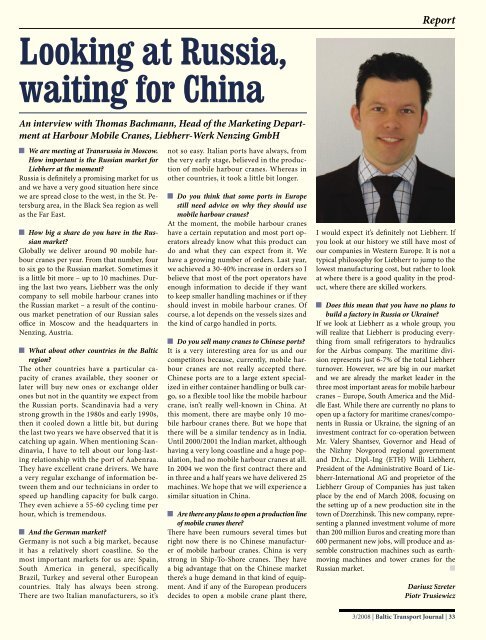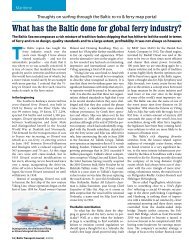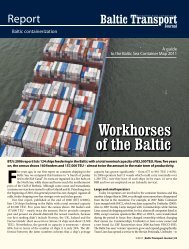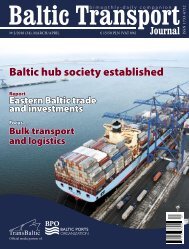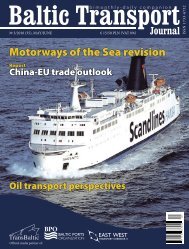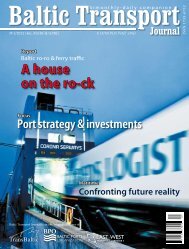Create successful ePaper yourself
Turn your PDF publications into a flip-book with our unique Google optimized e-Paper software.
Looking at Russia,<br />
waiting for China<br />
An interview with Thomas Bachmann, Head of the Marketing Department<br />
at Harbour Mobile Cranes, Liebherr-Werk Nenzing GmbH<br />
We are meeting at Transrussia in Moscow.<br />
How important is the Russian market for<br />
Liebherr at the moment?<br />
Russia is definitely a promising market for us<br />
and we have a very good situation here since<br />
we are spread close to the west, in the St. Petersburg<br />
area, in the Black Sea region as well<br />
as the Far East.<br />
How big a share do you have in the Russian<br />
market?<br />
Globally we deliver around 90 mobile harbour<br />
cranes per year. From that number, four<br />
to six go to the Russian market. Sometimes it<br />
is a little bit more – up to 10 machines. During<br />
the last two years, Liebherr was the only<br />
company to sell mobile harbour cranes into<br />
the Russian market – a result of the continuous<br />
market penetration of our Russian sales<br />
office in Moscow and the headquarters in<br />
Nenzing, Austria.<br />
What about other countries in the <strong>Baltic</strong><br />
region?<br />
The other countries have a particular capacity<br />
of cranes available, they sooner or<br />
later will buy new ones or exchange older<br />
ones but not in the quantity we expect from<br />
the Russian ports. Scandinavia had a very<br />
strong growth in the 1980s and early 1990s,<br />
then it cooled down a little bit, but during<br />
the last two years we have observed that it is<br />
catching up again. When mentioning Scandinavia,<br />
I have to tell about our long-lasting<br />
relationship with the port of Aabenraa.<br />
They have excellent crane drivers. We have<br />
a very regular exchange of information between<br />
them and our technicians in order to<br />
speed up handling capacity for bulk cargo.<br />
They even achieve a 55-60 cycling time per<br />
hour, which is tremendous.<br />
And the German market?<br />
Germany is not such a big market, because<br />
it has a relatively short coastline. So the<br />
most important markets for us are: Spain,<br />
South America in general, specifically<br />
Brazil, Turkey and several other European<br />
countries. Italy has always been strong.<br />
There are two Italian manufacturers, so it’s<br />
not so easy. Italian ports have always, from<br />
the very early stage, believed in the production<br />
of mobile harbour cranes. Whereas in<br />
other countries, it took a little bit longer.<br />
Do you think that some ports in Europe<br />
still need advice on why they should use<br />
mobile harbour cranes?<br />
At the moment, the mobile harbour cranes<br />
have a certain reputation and most port operators<br />
already know what this product can<br />
do and what they can expect from it. We<br />
have a growing number of orders. Last year,<br />
we achieved a 30-40% increase in orders so I<br />
believe that most of the port operators have<br />
enough information to decide if they want<br />
to keep smaller handling machines or if they<br />
should invest in mobile harbour cranes. Of<br />
course, a lot depends on the vessels sizes and<br />
the kind of cargo handled in ports.<br />
Do you sell many cranes to Chinese ports?<br />
It is a very interesting area for us and our<br />
competitors because, currently, mobile harbour<br />
cranes are not really accepted there.<br />
Chinese ports are to a large extent specialized<br />
in either container handling or bulk cargo,<br />
so a flexible tool like the mobile harbour<br />
crane, isn’t really well-known in China. At<br />
this moment, there are maybe only 10 mobile<br />
harbour cranes there. But we hope that<br />
there will be a similar tendency as in India.<br />
Until 2000/2001 the Indian market, although<br />
having a very long coastline and a huge population,<br />
had no mobile harbour cranes at all.<br />
In 2004 we won the first contract there and<br />
in three and a half years we have delivered 25<br />
machines. We hope that we will experience a<br />
similar situation in China.<br />
Are there any plans to open a production line<br />
of mobile cranes there?<br />
There have been rumours several times but<br />
right now there is no Chinese manufacturer<br />
of mobile harbour cranes. China is very<br />
strong in Ship-To-Shore cranes. They have<br />
a big advantage that on the Chinese market<br />
there’s a huge demand in that kind of equipment.<br />
And if any of the European producers<br />
decides to open a mobile crane plant there,<br />
Report<br />
I would expect it’s definitely not Liebherr. If<br />
you look at our history we still have most of<br />
our companies in Western Europe. It is not a<br />
typical philosophy for Liebherr to jump to the<br />
lowest manufacturing cost, but rather to look<br />
at where there is a good quality in the product,<br />
where there are skilled workers.<br />
Does this mean that you have no plans to<br />
build a factory in Russia or Ukraine?<br />
If we look at Liebherr as a whole group, you<br />
will realize that Liebherr is producing everything<br />
from small refrigerators to hydraulics<br />
for the Airbus company. The maritime division<br />
represents just 6-7% of the total Liebherr<br />
turnover. However, we are big in our market<br />
and we are already the market leader in the<br />
three most important areas for mobile harbour<br />
cranes – Europe, South America and the Middle<br />
East. While there are currently no plans to<br />
open up a factory for maritime cranes/components<br />
in Russia or Ukraine, the signing of an<br />
investment contract for co-operation between<br />
Mr. Valery Shantsev, Governor and Head of<br />
the Nizhny Novgorod regional government<br />
and Dr.h.c. Dipl.-Ing (ETH) Willi Liebherr,<br />
President of the Administrative Board of Liebherr-International<br />
AG and proprietor of the<br />
Liebherr Group of Companies has just taken<br />
place by the end of March <strong>2008</strong>, focusing on<br />
the setting up of a new production site in the<br />
town of Dzerzhinsk. This new company, representing<br />
a planned investment volume of more<br />
than 200 million Euros and creating more than<br />
600 permanent new jobs, will produce and assemble<br />
construction machines such as earthmoving<br />
machines and tower cranes for the<br />
Russian market.<br />
Dariusz Szreter<br />
Piotr Trusiewicz<br />
3/<strong>2008</strong> | <strong>Baltic</strong> <strong>Transport</strong> <strong>Journal</strong> | 33


